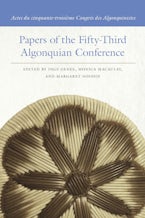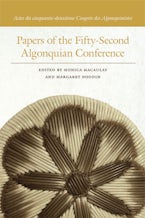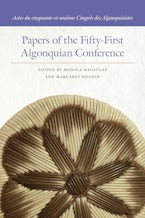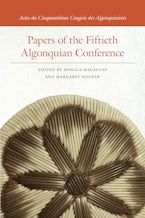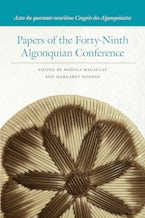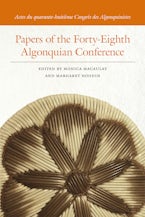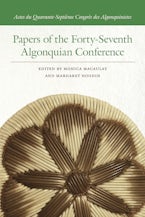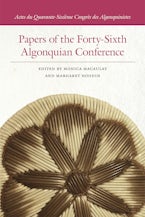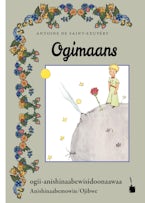Papers of the Algonquian Conference is a collection of peer-reviewed scholarship from an annual international forum that focuses on topics related to the languages and cultures of Algonquian peoples. This series touches on a variety of subject areas, including anthropology, archaeology, education, ethnography, history, Indigenous studies, language studies, literature, music, political science, psychology, religion, and sociology. Contributors often cite never-before-published data in their research, giving the reader a fresh and unique insight into the Algonquian peoples and rendering these papers essential reading for those interested in studying Algonquian society.
ContentsPreface | Marie-Odile Junker and Christopher CoxThe Assumption of a Further Obviative | Irene AppelbaumPossessive Prefixes across Algonquian: Evidence for Two Separate Paradigms | Ksenia BogomoletsStories of Empowerment: Indigenous Women’s Leadership Summer School | Maggie Chittspattio, Nadia Ferrara, Ashley Guanish, Mary Jane Hannaburg, Denise Larocque, Amélie La Rose Gauthier, Anahi Morales Hudon, Anny Morissette, and Marie-Louise PerronAnimate Intransitive Consonant Stems in North East Cree | Vincent Collettesk and sp in Illinois | David J. Costakwêyask kotahâskwâtam: The Effects of Altering Specificity in WordNet on the Accuracy of Computational Semantic Classifications of Plains Cree (nêhiyawêwin) | Daniel Dacanay, Jolene Poulin, and Antti ArppeThe Meskwaki Past Tense Enclitic =iyo·we in Relation to an Affixal Past Tense Strategy | Amy DahlstromEzhi-Aanikanootamaang Ogimaans: The Little Prince Translated into Ojibwemowin | Jaymee Dhein, Angela Mesic, Margaret Noodin, and Susan WadeDeverbal Noun Composition in Mille Lacs Ojibwe | Hunter Johnson and Christopher HammerlySyllabicity of Dorsal Fricative [X] in Blackfoot: An Empirical Investigation | Mizuki MiyashitaPatterns of Cree Preverb Usage in Early Child Language: A Longitudinal Case Study | Burak OneyShort Verbs in Algonquian } Richard A. RhodesReflections of a “Barbarous, Mentally Undeveloped” Linguist: On the Legacy and Obligations of Algonquian Studies and Linguistics | Mskwaankwad RicePlains Cree Textual Analysis with PCA: Across the Bloomfield and Ahenakew-Wolfart Subcorpora | Katherine Schmirler and Antti ArppeMorphophonological Rule Development and Real-Time Rule Testing with XFST: A Model for Blackfoot | Katherine Schmirler, Antti Arppe, and Inge GeneeOn Diphthongs and Digraphs in Blackfoot | Natalie Weber and Mizuki MiyashitaRhythm and Intonation in Oji-Cree | Matthew WindsorOblique Argument Licensing in Algonquian: Head Marking vs. Dependent Marking | Yadong XuContributors
Inge Genee is coeditor of the Blackfoot Digital Dictionary and director of the Blackfoot Language Resources Lab, which conducts collaborative research in support of Blackfoot language revitalization. She received a PhD in linguistics from the University of Amsterdam. She is a professor at the University of Lethbridge, where she teaches courses in linguistics and Blackfoot grammar.
Monica Macaulay received her PhD in linguistics from the University of California–Berkeley. She is the Ada Deer Professor of Language Sciences at the University of Wisconsin–Madison and on the board of the Endangered Language Fund, a nonprofit organization that funds language revitalization and preservation projects around the world. She also works closely with the Menominee Indian Tribe of Wisconsin on language reclamation and revitalization.
Margaret Noodin received an MFA in creative writing and a PhD in English and linguistics from the University of Minnesota. She is Head Start director and Ojibwemowin instructor for the Grand Portage Band of Lake Superior Chippewa. She is also a professor at the University of Wisconsin–Milwaukee where she teaches Anishinaabemowin, literature, and poetry online. Her work has included co-creation of www.ojibwe.net, publication of two bilingual collections of poetry in Anishinaabemowin and English and numerous translations of children’s books.

